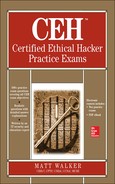
Ethical Hacking Basics
This domain includes questions from the following topics:
• Identifying basic elements of information security
• Understanding security, functionality, and ease of use
• Defining and profiling an ethical hacker
• Defining classifications of hackers and terms associated with hacking
• Understanding the five stages of ethical hacking
• Defining the types of system attacks
• Understanding U.S. Federal laws related to cyber crime
• Understanding various international laws related to cyber crime
In one of my earliest memories, I’m sitting at the table on Thanksgiving, staring lovingly at a hot apple pie being sliced into pieces and doled out onto plates. I remember watching an ice cream bowl chase the pie slices around the table, and each person scooping out delicious vanilla goodness for the top of their pie. And I remember looking at that flaky crust and the sugary, syrupy insides and thinking how great it was going to be when I got mine. But then I remember my mom looking right at me and saying, “Looks good, doesn’t it? All you’ve got to do is finish your vegetables and you can have some.”
I dearly love apple pie a la mode. It’s my favorite dessert on the planet—my ambrosia, if you will. I love it so much that aggressively displacing toddlers out of my way to get to dessert nirvana isn’t out of the question (okay, maybe just sternly threatening them, but you get the idea). But I absolutely despised most of the veggies I was forced to eat as a kid. Greens, peas, carrots, asparagus? Might as well have been kryptonite for Superman. Why not just ask me to stab my eyes out with a fork—or, worse yet, ask me to wear Auburn colors, Mom?
But when push came to shove, I ate the vegetables. Not because I liked them or because I wanted to, but because I had to in order to get what I really wanted.
Welcome to your veggie plate, dear reader. No, it’s not the exciting dessert you’re drooling over—all those sexy hacking questions come later—but this is stuff you just have to get out of the way first. The good news with this part of your exam is that this is the easy stuff. It’s almost pure memorization and definitions—with no wacky formulas or script nuances to figure out. And don’t worry, it’s not nearly as bad as you think it’s going to be. At least I’m not making you put on blue and orange.
When it comes to studying this chapter, where mostly definitions and rote memorization are all that is required for the exam, repetition is the key. Tables with words on one side and corresponding definitions on the other can be pretty effective—and don’t discount the old-school flash cards either. When studying, try to find some key words in each definition you can associate with the term. That way, when you’re looking at a weird test question on the exam, a key word will pop out and help provide the answer for you.
For example, the most confusing questions for you in this section will probably come from the CIA triad and the methodology steps. Be careful with confidentiality versus integrity (watch out for that pesky authentication word as well), and know the methodology like the back of your hand. Concentrate on key words for each, and you should be fine.
Additionally, at the risk of generating derision from the “Thank you, Captain Obvious” crowd, here’s another piece of advice I have for you: Spend your time on the things you don’t already know (trust me, I’m on to something here). Many exam prospects and students spend way too much valuable time repeating portions they already know, instead of concentrating on the things they don’t. If you understand the definitions regarding white hat and black hat, don’t bother reviewing them over and over. Instead, spend your time concentrating on areas that aren’t so “common sense” to you.
And, finally, keep in mind that this certification is provided by an international organization. Therefore, you will sometimes see some fairly atrocious grammar on test questions here and there, especially in this section. Don’t worry about it—just keep focused on the main point of the question and look for your key words.
 STUDY TIPS When it comes to studying this chapter, where mostly definitions and rote memorization is all that is required for the exam, repetition is the key.
STUDY TIPS When it comes to studying this chapter, where mostly definitions and rote memorization is all that is required for the exam, repetition is the key.
..................Content has been hidden....................
You can't read the all page of ebook, please click here login for view all page.
